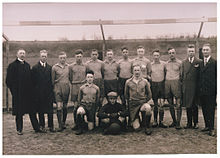Heinrich Kloppers
Heinrich Kloppers (born July 14, 1891 in Hagelshoek , today Bad Bentheim , † November 24, 1944 in Neuengamme concentration camp ) was a German worker and resistance fighter against National Socialism .
Life
Kloppers grew up as the son of a Dutch immigrant and his German wife in the village of Gildehaus ( Grafschaft Bentheim district ) near the Dutch border, was raised in a very Christian way and learned the trade of weaver in the local textile industry . During the First World War he was wounded on the Western Front . The first thoughts on a pacifist attitude originate from this time .
After the war returned to Kloppers Gildehaus back a short time a member has been a volunteer corps , again working in the textile industry. In 1924 he married. A daughter comes from the connection. From 1924 onwards, Kloppers played a key role in building up the left wing in the village. He was a founding member of the local branch of the Reichsbanner Schwarz-Rot-Gold , a member of the Free Trade Union and chairman of the football department of the local workers' gymnastics club . The political radicalization did not spare the village, which has around 1700 inhabitants. The National Socialists found great popularity in Gildehaus , especially since the NSDAP district leader and member of the Reichstag , the doctor Dr. Josef Ständer , lived in the village. In 1929 Kloppers became a council member of the unified workers list. Several clashes with the NSDAP can be traced back to 1933 . Kloppers helped the distressed DVP mayor Ernst Buermeyer , who fled to Holland.
Kloppers, meanwhile a health inspector at the AOK in the nearby district town of Bad Bentheim , lost this post in 1933 because he did not want to join the NSDAP. He became unemployed, became ill and after his recovery worked temporarily in road construction. A personal hostility to the NSDAP district leader developed. The entire left (remaining) milieu of the village was under observation by the Gestapo and the SD . As an informal opinion leader of the opposition, Kloppers also said his opinion after 1933, although friends and relatives often warned him, sometimes without make-up, sometimes camouflaged (e.g. about the sale of “Jewish furniture”). He led an illegal social democratic debating group and devoted himself increasingly to Christian youth work. He observed the National Socialist milieu closely and made secret records about it.
After the assassination attempt on July 20, 1944 , Kloppers was arrested together with the former Nordhorn communist leader Ferdinand Kobitzki in the course of the Gewitter campaign , and after a few weeks he was sent to the Neuengamme concentration camp . In the meantime, Kloppers managed to send home several letters from the court prisons in Bentheim and Osnabrück , in which he also wrote about torture. Although the Nordhorn textile manufacturer and later CDU member of the Bundestag Dr. Bernard Povel , in whose factory Kloppers worked as a weaver in 1944, campaigned for his workers, Kloppers was arrested and taken to Neuengamme concentration camp. The political assessment of the NSDAP district leadership: “Was an SPD council member in Gildehaus / Bentheim. After 33 he belonged to the opposition and was always a nagger and complainer. Is one of the most dangerous in the Bentheim district, who mainly plays a hidden game. "
Kloppers died on November 24, 1944, allegedly at 4:00 a.m. of pulmonary consumption , in Neuengamme concentration camp. The burial of the urn in January 1945 turned into an impressive demonstration by his friends, the church and the non-Nazified section of the working class.
After the Second World War , attempts were made to deal with the case under criminal and civil law.
In 1985, Heinrich-Kloppers-Strasse in Gildehaus, where Kloppers' former house is located, was named after him. On August 16, 2007, the Cologne artist Gunter Demnig laid a “stumbling stone” in front of Klopper's house (house numbers 1–3) as a souvenir.
literature
- Herbert Wagner : The Gestapo wasn't alone ... Political social control and state terror in the German-Dutch border area 1929–1945. LIT-Verlag, Münster 2004, ISBN 978-3-8258-7448-3 .
Individual evidence
- ↑ Grafschafter Nachrichten of November 26, 2007: "We must not be silent". Gildehaus reminds of resistance fighter Heinrich Kloppers .
- ↑ Grafschafter Nachrichten of August 17, 2007: "A bow to the victims". Stumbling blocks moved in Gildehaus - memory of Jewish victims and a resistance fighter .
| personal data | |
|---|---|
| SURNAME | Kloppers, Heinrich |
| BRIEF DESCRIPTION | German resister against the Nazi regime |
| DATE OF BIRTH | July 14, 1891 |
| PLACE OF BIRTH | Hagelshoek |
| DATE OF DEATH | November 24, 1944 |
| Place of death | Neuengamme concentration camp |
